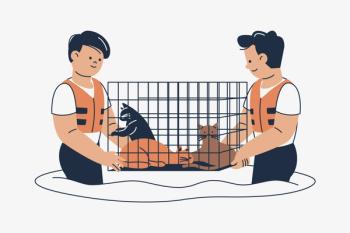Antimicrobial resistance to C. jejuni is becoming an issue, Dr. Brown said. Although most people with campylobacteriosis don’t require antibiotics, patients with serious infections do sometimes receive empirical treatment with macrolides or fluoroquinolones, she noted. However, drug resistance in Campylobacter isolates has been on the rise since 1997, especially to fluoroquinolone antibiotics.
Direct contact with C. jejuni-infected animals also poses a risk to people, Dr. Brown said. Healthy dogs, for example, can be carriers of the organism, and those living in conditions of crowding are more likely to be infected. Clinical infection in dogs occurs more commonly in puppies younger than 12 months, she says, and contact with puppies is a significant risk factor for the disease in people.
A multistate outbreak of campylobacteriosis
Dr. Brown discussed the public health response to an outbreak of campylobacteriosis that lasted from January 2016 to January 2018. The outbreak spanned several states and was linked to puppies sold through a national chain of pet stores, Dr. Brown said.
The first human cases were reported in Florida in July 2017 in four people who reported exposure to the same retail pet chain. One month later, five more cases were identified in Ohio, in people who also reported exposure to the same pet chain. Molecular testing of fecal samples from three dogs from the Florida and Ohio retail pet locations showed that the bacterial isolates were related, indicating the potential for an outbreak.
A Centers for Disease Control and Prevention (CDC) investigation prompted state public health officials to review records to identify previous campylobacteriosis cases in people who had reported being exposed to puppies.
As of January 2018, nationwide data had identified a total of 113 cases of campylobacteriosis associated with this outbreak in 17 states. Affected people ranged in age from younger than 1 to 86 years, with a median age of 27 years; 63% were female. More than one-fifth (22%) of the people affected in the outbreak were hospitalized, Dr. Brown said. Common risk factors for human infection in the outbreak included contact with puppies within 7 days before onset of symptoms (99%), some contact with the retail pet chain (87%) and employment at the retail pet chain (23%).
Whole-genome sequencing of Campylobacter organisms from clinical specimens from infected people also showed that their isolates were genetically related and were thus more likely than not to share a common source of infection.
To identify puppies from the retail pet chain that were carrying the outbreak Campylobacter strain, officials collected fecal samples from puppies for laboratory testing. They also reviewed medical records to determine which animals had received antibiotics. DNA of Campylobacter isolates from affected puppies showed close relationships between these organisms and those isolated from affected people. This again suggested a common source of the bacteria, said Dr. Brown.
This strong multidrug resistance pattern was of public health significance because it was a new phenomenon, according to Dr. Brown. Of approximately 12,000 C. jejuni surveillance isolates reported between 2005 and 2015, this particular multidrug resistance pattern was reported only 36 times (0.3%). This means that first-line antibiotics typically used to treat these infections wouldn’t have been effective, she says. And this is especially concerning because of the high rate of hospitalizations (22%) in people affected in this outbreak, she stressed.
The investigation ultimately failed to identify a common source of the disease outbreak among breeders, transporters or distributors in any state. However, the multidrug-resistant C. jejuni organism is probably widely disseminated in the pet retail industry, she said. This likely relates to several factors at different stages in the supply chain, including inconsistent infection control practices and commingling of puppies from different points in the supply chain.
Administration of antibiotics to puppies before their transport to retail locations was also a contributing factor, she says. During the investigation, officials examined the records of 141 puppies and found that more than one-third (38%) had received antibiotics for a combination of treatment and prophylaxis, and more than half (55%) for prophylaxis only. Only 1% of the puppies had received antibiotics for just treatment purposes.
Help to prevent zoonotic transmission of C. jejuni infection
To really make One Health approaches to zoonotic disease catch on will take advice and education from everyone involved. In your community, could you and your veterinary hospital team be part of the solution on social media, in local media and in education at pet stores? Here are recommendations from the CDC on the C. jejuni outbreak with tasks for each stakeholder in human-animal relationships:
- Pet owners need education on 1) proper handwashing, 2) proper sanitation measures to use when cleaning animal areas and 3) when to seek veterinary care for sick puppies.
- Pet store employees need education on 1) proper handwashing, 2) proper sanitation measures to use when cleaning animal areas, 3) proper personal protective equipment when cleaning animal areas and 4) the importance of storing their food away from animal areas.
- Physicians and other human healthcare providers need to 1) make patients aware of the multidrug-resistant strain of C. jejuni and 2) promote antimicrobial stewardship among patients.
- Veterinarians need to 1) educate clinic staff and clients about proper handwashing and sanitation measures when handling and cleaning puppies and the areas where they’re housed, 2) educate clients about the risks of zoonotic disease transmission, 3) advise clients about the need to seek immediate veterinary care for puppies that become ill and 4) perform diagnostic testing for C. jejuni in puppies with clinical signs suggestive of infection with the bacterium, especially in those with bloody mucoid diarrhea.
Preventing future outbreaks: Where you come in
The fact that so many of the puppies had received antibiotics only for prophylaxis represents a good opportunity for intervention, according to Dr. Brown, who stresses the need to educate individuals at different points in the supply chain about antimicrobial stewardship.
Because of the need to increase awareness of this particular multidrug-resistant strain of C. jejuni in puppies, the CDC recommended that veterinarians and healthcare providers take steps to educate patients and clients about best practices to help prevent further outbreaks of this infection. (See “Help to prevent zoonotic transmission of C. jejuni infection.”) In particular, Dr. Brown concluded that pet owners and pet store employees need education about good hygiene practices and also about the need to seek veterinary care immediately for puppies that become ill.
Nicola Parry, BVSc, MRCVS, MSc, DACVP, FRSPH, ELS, is an independent veterinary pathology consultant with Midwest Veterinary Pathology in Lafayette, Indiana.





